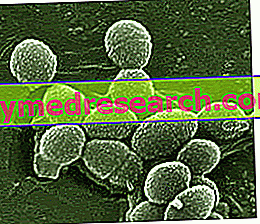What are Calli
The calluses are annoying thickening of the skin that can originate in any point of the soles of the feet (often), of the palms of the hands (less frequently) or between the fingers, due to the perpetuation of local insults such as pressure, irritation and friction.

In medical language, calluses are a benign pseudopathological condition known precisely as " hyperkeratosis ".
Causes
The causes of callus formation can be different. Depending on the trigger, we can distinguish two different categories:
- Friction corns
- Corns related to diseases, disorders or poisonings (from arsenic)
The main characteristics of the aforementioned types of corns will be briefly described below.

In the figure we can see (on the right) the hyperproliferation of the stratum corneum of the epidermis (superficial layer of the skin) that is at the base of the calluses.
Attrition Corns
The most common causes of corn formation are to be found in the friction (rubbing) and pressure exerted at the area affected by the disturbance.
In a sense, the calluses are a protection for the skin in the area where they sprout: they, in fact, manifest themselves as a defense mechanism designed to protect the living cells of the epidermis (present in the deeper layers of the same) which - in response to continuous mechanical insults - they increase the processes of keratinization. Not surprisingly, the calluses of the hands and feet are always formed on a precise point of the skin exposed to continuous rubbing or exaggerated pressure.
The table shows the risk factors most frequently responsible for the growth of friction calluses on hands and feet.
The calluses can appear due to ... | Corns of hands may come up due to ... |
|
|
Corns from diseases or poisonings
This particular type of corns can appear independently of pressure, rubbing or friction on the skin. This form of hyperkeratosis has a multifactorial origin; the causes involved in the formation of these calluses can be found in terrible diseases such as syphilis, or in the intake of certain toxins or poisons such as arsenic.
In addition to the factors listed above, there is another benign condition potentially responsible for callus formation: it is palmar and plantar keratosis, which produces small skin thickenings between the folds of the fingers and toes.
Finally, even actinic keratosis - induced by overexposure to the sun - can be the main cause of the callous phenomenon.
Risk factors
Patients suffering from structural foot abnormalities, which present with bone spurs or lumpy fingers, are statistically more exposed to the risk of foot calluses than healthy subjects.
However, even some not entirely correct behaviors actually increase the possibility of developing similar injuries. For example, the use of unsuitable or too tight shoes, as well as the habit of not wearing socks, cause greater friction in some areas of the foot, thus causing corns.
Features

Despite being able to originate also in the palm of the hands, the calluses are usual to tick on the soles of the feet or between the fingers since these areas are continually subjected to pressure and rubbing.
Depending on where they are located, hard calluses can be distinguished from soft calluses.
Hard calluses tend to grow on the upper part of the fourth and fifth toes, or on the outer side of the fifth. Hard calluses are also typical of the hands.
The soft calluses form between the toes, often between the fourth and fifth toes. This calluses have a more spongy and soft consistency due to the sweat that stagnates between the toes; for the same reason, the soft calluses are more easily infected than the hard ones.
Some calluses have a much thicker part in the center and a pointed bottom such as to create a pain similar to a pin prick when resting the foot to walk.
Symptoms
Normally, calluses do not cause a particularly significant symptomatology, in fact, in themselves, they are painless. However, when they grow in certain foot positions they can cause discomfort, pain or even compromise posture and walking.
Different speech for the calluses that arise on the feet of a diabetic patient: in similar circumstances, the callus generally goes unnoticed because of the altered sensitivity at the level of the foot, typical of diabetes. As the callus progresses, it can cause extremely dangerous ulcers, to the point of exaggeratingly increasing the risk of skin infections, thus of gangrene.
Patients suffering from diabetes - as we will deepen in the next article ("Calli - Cura and Prevention") - must pay extreme attention to the care and hygiene of their feet because even the presence of a small and apparent harmless callus can degenerate into extremely complicated complications serious.
Diagnosis
As mentioned, normally, calluses do not cause symptoms that can make patients particularly worried.
However, if these thickenings of the epidermis cause pain and discomfort and in the event that they compromise the movements, it is good to consult the doctor.
Normally, a quick glance at the skin lesion in question is sufficient for the doctor to make the diagnosis. It must, however, be careful not to confuse calluses with other diseases that manifest themselves with similar signs and symptoms, such as warts.
At the same time, once the corns have been diagnosed - in order to undertake the correct therapeutic strategy - the doctor will have to identify the underlying causes of the disorder (mechanical insults, pathologies, possible poisonings, etc.).
Continue: Corns - Care and Prevention »



